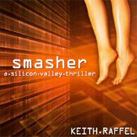
Ebook
You can order the ebook format of Smasher at these online
retailers:


Trade Paperback
You can order the trade paperback format of Smasher at
these online retailers:
Smasher
Behind the Book
My wife and children are careful to correct anyone who calls me a native of California. Seventh- and
eighth-generation Californians, respectively, they view me as a greenhorn just off the boat. Although
I’m Chicago-born, I have lived in Palo Alto in the midst of Silicon Valley since I was 8 years old, before it was
Silicon Valley, when it was still known as the Valley of Heart’s Delight. Back then, two-thirds of
the nation’s apricots were grown here and San Jose, now one of the 10 largest cities in the United
States, was a sleepy canning town.
Still, while I was growing up, I did have some clues as to the wondrous things that were happening
hereabouts. My dad worked on the first videotape recorders as an engineer at Ampex. I went to high school with the
children of Hewlett and Packard. Bob Noyce at Intel was developing the microprocessor, Doug Engelbart
was putting together a wooden prototype of the computer mouse, and Bob Metcalf and Dave Boggs at Xerox
PARC were coming up with the Ethernet networking protocols. Today these achievements make up whole
chapters of the Valley’s creation story.
Something else was going on back then that I didn’t notice at all. Over at the Stanford
Linear Accelerator Center (SLAC), physicists were discovering what our universe is made of.
You’ve seen that picture of an atom with spheres clustered in the middle representing neutrons and
protons and electrons whirling in orbit around them? It’s employed as an icon to symbolize
cutting-edge science. But everything in the picture is wrong. Protons and neutrons are not balls;
they’re made up of three particles called quarks (which come in six flavors: up, down, top, bottom, strange, and beauty).
I know your new Mac, PC, or iPhone with the incredible user interface and fast graphics accelerator chip
is cool. And for all I know, you thank the gods of Silicon Valley everyday for developing its underlying
technology. But is it cooler than the building blocks of the universe, the leftovers from the Big
Bang?
I took a tour of the building at SLAC where quarks were discovered four decades ago. And you know what?
It’s a warehouse. Thomas Edison’s lab is a national
historical park. The Wright Brothers’ Kitty Hawk is a national
memorial. But in the midst of Silicon Valley, the very place where scientists identified key
building blocks of the universe is filled with dusty boxes.
What kind of people made that discovery? Shouldn’t they be celebrated? Maybe, but in a work of
fiction, cautiously. As a thriller writer, my main job is to entertain. But I figured I could sneak in a
fictionalized story of the discovery of quarks. Fun physics? Sure. What if someone were zapped by an
electron beam moving at more than 99 percent of the speed of light? The key was focusing not on the
particles, but on the people.
So how could I tell the story in compelling fashion? Nothing makes even a crotchety man like me a
feminist faster than having daughters. And I have three of them. Somewhere along the way, I picked up a
book on Rosalind Franklin.
Her work provided the key that opened the door to the discovery of the structure of DNA. But James Watson, who won a Nobel
Prize for this discovery, disses her badly in his book Double Helix. He wrote: “The real
problem, then, was Rosy. The thought could not be avoided that the best home for a feminist was in
another person’s lab.” In fact, Dr. Franklin was one of the top experimental scientists of
the last century. Her lab colleague showed Watson an X-ray she had taken, and it was that picture that
demonstrated to Watson the double helix topography of DNA. Franklin died at 37, never knowing the vital
role her research had played in that discovery. Now there’s a story fraught with intrigue,
personalities, and high stakes. I borrowed from the outlines of Rosalind Franklin’s life by giving
Smasher’s protagonist, Ian Michaels, a great aunt who made a key discovery about quarks
in the 1960s at SLAC. She died young and without the Nobel Prize her colleagues received. It falls to
Ian to win her posthumous justice. I try not to be too preachy or didactic and focus on the plot, rather
than the physics or the lessons learned.
But injustice two generations old was not a big enough hook to hang a thriller on. I also wanted to
infuse Smasher with some of what I’d experienced – as a child and an entrepreneur
– in Silicon Valley. How the Valley operates reminds me of the scene in The Godfather where
a
gangster excuses a murder by saying, “It’s not personal, Sonny. It’s strictly business.” Here in the
Valley, “it’s strictly business” justifies almost anything. If there’s a chance
for an investor to extract some more shares of stock from the founder of a company, go ahead--
it’s business. If one corporate director hires a private investigator to spy on a fellow board
member--well, that’s business, too.
It’s against this background that Smasher’s Eddie Frankson operates. He’s the
CEO of Torii Networks and the second richest man in California. I’ve met some of the
Valley’s biggest names, but he’s not based on any one of them. Smart and ruthless, Frankson
sees it’s a good time for “a smash and grab” of Ian’s company. That’s the
way these things work.
So now I had two story lines. In the first, Ian seeks to obtain recognition for his great aunt’s
seminal discovery. At the same time he is fending off a predator who’s ready to wolf down his
company. In the midst of all this, Ian’s wife, Rowena Goldberg, a deputy district attorney, is
trying her first murder case. It’s a frenetic combination of events, but that’s how things
work in Silicon Valley.
I had the characters and the setting for the book then. All (?!) I needed was a plot. Where would that
come from? I waited for inspiration to strike. And then it did.
I’ve long wondered where inspiration comes from. If I wake up in the middle of the night with the
answer for the plot twist, did it come from my subconscious? The gods? I don’t know.
Smasher was a new experience, because this time I know the source of the spark. I was walking
down Castro Street in the town of Mountain View talking to my polymathic friend Brian Rosenthal
(who’s been an auto mechanic, a psychologist, and a high-school science teacher), when he said
something about Nobel Prizes. A supernova exploded in my brain. Bingo! Smasher starts when
someone in a black car runs down Ian’s wife. Who was driving that vehicle? Why was Rowena the
target? Sorry to be coy, but I don’t want to spoil the book for potential readers. As they say in
the movies and here in Silicon Valley, “It’s not personal. It’s strictly
business.”